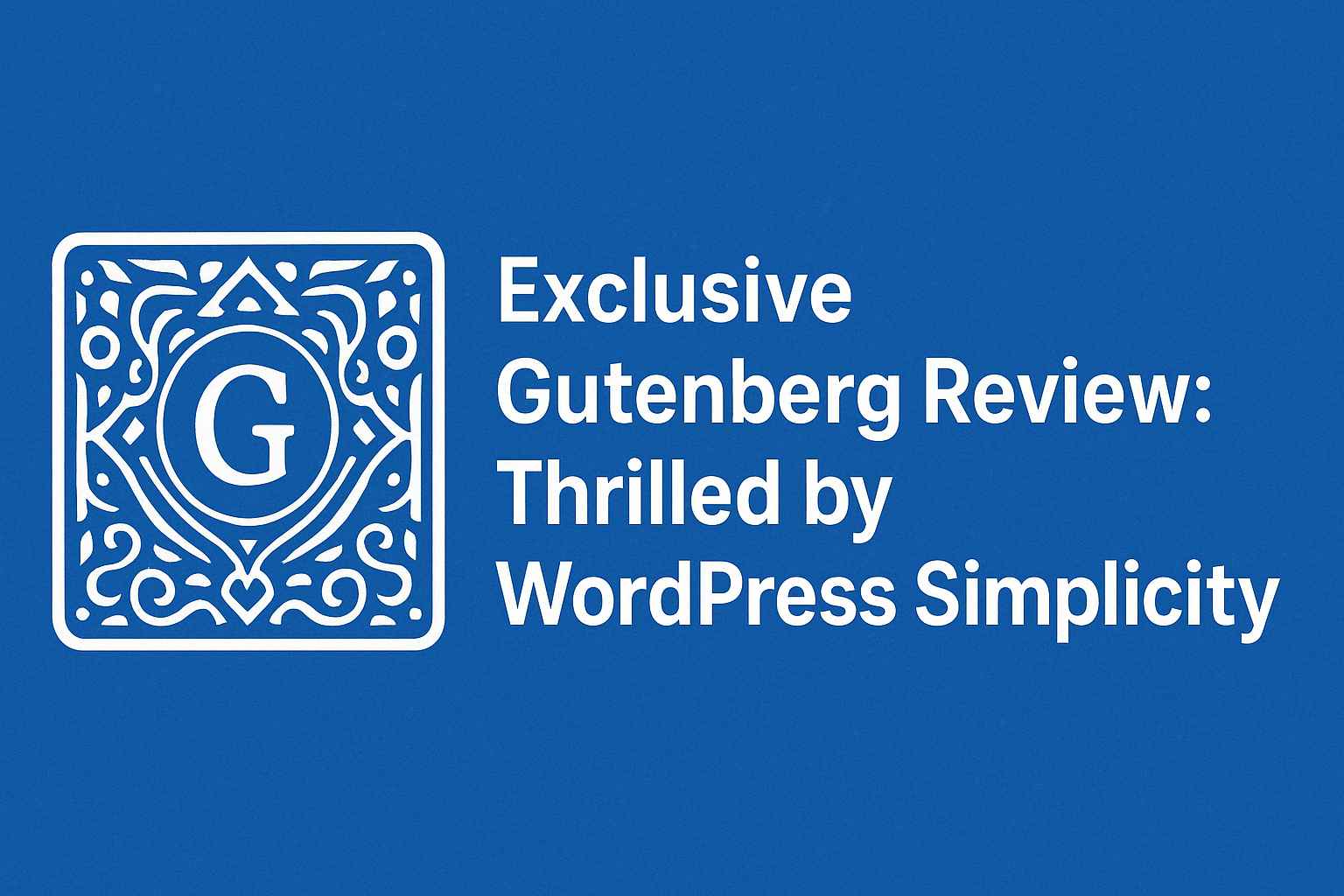Is Gutenberg the Future of WordPress Website Building?
When WordPress first launched Gutenberg as its new block editor in 2018, the web community was buzzing with excitement and a hint of skepticism. Traditionalists clung to the familiar Classic Editor, while others welcomed the promise of a more visual page-building experience—one that felt tailored to modern websites. Fast forward to today, and Gutenberg has matured into much more than just a replacement editor. Here is the detailed analysis of Gutenberg review.
If you’ve ever asked yourself, “Is Gutenberg a real page builder?” or “How does it stack up against other options?”—this article is for you. We’ll dive deep into what Gutenberg offers, its standout features, real-world usability, a balanced look at pros and cons (tabular format included!), and even a transparent breakdown of pricing so you can see if it aligns with your needs.
What is Gutenberg? A Quick Overview
Gutenberg is not just a text editor—it’s WordPress’s core block-based builder and editor. Imagine constructing your pages block by block, just like arranging digital Lego pieces. Each “block” can be paragraphs, images, columns, buttons, or even entire layouts.
How Does Gutenberg Work?
- Blocks: Gutenberg centers on blocks. Want a new heading? Drop in a heading block. Need a gallery? There’s a block for that too.
- Drag-and-Drop: Rearranging content is as easy as dragging blocks up and down the page.
- Templates: With patterns and reusable blocks, you can swiftly set up complex layouts.
- Extensibility: Developers and plugin authors are constantly creating custom blocks, expanding what’s possible.
“Gutenberg has revolutionized how I build pages—it feels intuitive and, with a little practice, is genuinely fun to use.”
Key Features: Is Gutenberg a True Competitor in the Page Builder Space?
Let’s take a closer look at what makes Gutenberg worth considering (or perhaps not, depending on your workflow).
Block Library
- Default Blocks: Text, image, list, quote, heading, gallery, video, columns, and more.
- Third-Party Blocks: Extend the library with plugins like Stackable or Atomic Blocks.
- Custom Blocks: Developers can create bespoke blocks tailored to specific needs.
Layout & Design Options
- Drag-and-drop block movement—though not fully free-form like some visual builders.
- Columns & Groups for multi-column layouts.
- Patterns: Pre-designed layouts for fast page assembly.
- Styling: Some controls for color, typography, and spacing (though limited compared to tools like Elementor or Beaver Builder).
Reusable Content
- Reusable Blocks: Save and reuse custom block arrangements—handy for CTAs or author boxes.
- Block Patterns: WordPress 5.5+ introduced patterns to help with plugging in entire sections instantly.
Integrations & Compatibility
- Works seamlessly with most WordPress themes (especially “block-ready” or Full Site Editing themes like Twenty Twenty-Four).
- Plays well with standard plugins, but some complex layouts may need additional plugins.
Speed & Performance
- Core Gutenberg sites often load faster than those depending on heavy third-party builders—a genuine perk for SEO.
Pros and Cons of Gutenberg
Let’s weigh up the main strengths and drawbacks by comparing Gutenberg to other popular page builders:
| Pros (Advantages) | Cons (Limitations) |
|---|---|
| Native in WordPress core; no extra plugins needed | Fewer design/layout options compared to dedicated builders |
| Fast loading and lean code output | Some blocks lack advanced customization |
| Regularly updated and improving | Learning curve for those moving from Classic Editor |
| Vast library of both core and third-party blocks | Not all themes/styles fully support block customization |
| Free to use (open-source) | Advanced features require third-party add-ons or plugins |
| Reusable blocks and patterns for speedy workflow | No true drag-and-drop freeform positioning |
| Full Site Editing now available with compatible themes | Still maturing; features rapidly evolving |
Pricing Table: What Does Gutenberg Cost?
One of the biggest advantages people mention is cost. Let’s see how Gutenberg compares to popular alternatives:
| Page Builder | Core Price | Upgrade / Add-Ons | Notes |
|---|---|---|---|
| Gutenberg (WordPress core) | FREE | Pricing set by third-party block plugins* | Built-in with every WordPress install |
| Elementor (Free/Pro) | Free / $59+ per year | Add-ons: $20+ per year | Pro features and templates require the paid version |
| Beaver Builder | $99+ per year | Theme: $199+ per year | Whitelabel and multisite available |
| Divi (by Elegant Themes) | $89/year or $249/lifetime | N/A | All-in-one pricing, includes theme & builder |
| WPBakery | $64 one-time | Add-ons: Prices vary | Lifetime updates, but UI less modern |
“Advanced block plugins (e.g., Kadence Blocks, Stackable, Spectra) often offer free versions, with premium upgrades costing from $40 to $90/year for more layouts and custom controls.”
Real-World Insights: Who Should Use Gutenberg?
For Bloggers and Content Creators
Gutenberg shines for anyone who wants clean layouts without relying on extra plugins. Drag in a quote, image, or gallery—perfect for storytelling or magazine-style blogs.
For Developers and Agencies
Its extensibility means you can build custom blocks, control branding, and manage performance. Plus, using fewer plugins reduces site complexity for clients.
For Small Businesses and DIYers
If you’re starting out, Gutenberg means zero cost for page building (unless you need special features). You can expand with premium blocks if/when your site grows.
Tips for Getting the Most from Gutenberg
- Try a Block Theme: Use a theme built for Full Site Editing for the best experience (e.g., Twenty Twenty-Four or GeneratePress).
- Explore Add-Ons: Plugins like Kadence Blocks or Spectra add pro-level designs without a page builder’s bulk.
- Practice: At first, building pages block-by-block can feel odd, but with regular use, it becomes second nature.
- Check Compatibility: Some older plugins or themes may not play nicely with all block features yet.
“Start with Gutenberg for all new projects. If you need advanced layouts, layer in specialty block plugins instead of switching to an entirely different system.”
Conclusion: Gutenberg review—A Worthy Contender or Just Hype?
Gutenberg has undeniably brought WordPress into the modern era. Is it perfect? Not yet. For those craving super-advanced designs and drag-anywhere freedom, a dedicated page builder like Elementor or Divi might still hold appeal. But for many users—bloggers, businesses, developers—Gutenberg offers a lightweight, flexible, and cost-free solution built right into WordPress.
Experiment, play with blocks, and remember: Your site only needs as much complexity as your audience demands. Start with Gutenberg, and layer on extra power if (and only if) you truly need it.
Have you tried Gutenberg? What has your experience been so far? Share your thoughts or your favorite tips in the comments below!
Key Takeaway: Gutenberg is ushering in a new standard for WordPress site building—intuitive, fast, and (often) free. Give it a try, and see if it fits your creative process.






This was beautiful Admin. Thank you for your reflections.
Thank you for the good writeup It in fact was a amusement account it Look advanced to far added agreeable from you However how could we communicate